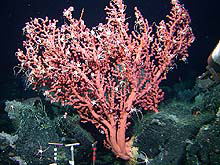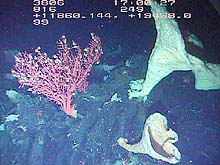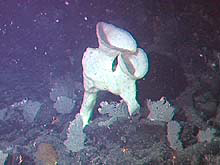
This large pink sea fan belongs to the genus Paragorgia. This specimen is nearly two meters tall and is held in place by a “holdfast” nearly 12 cm in diameter. It holds within its branches a thriving community of brittle stars, crabs, and shrimp - giving it the appearance of a well-decorated Christmas tree. Click image for larger view.
Warwick Seamount – Discovery of “A Garden of Eden” in The Gulf of Alaska
July 15, 2002
Catalina Martinez
NOAA Office of Ocean Exploration
Rob Dunbar, Professor
Stanford University
The last four days of our expedition were spent exploring Warwick Seamount, which was so biologically rich and unique that it was referred to as “The Garden of Eden” by several of the scientists on board. Our remaining days were filled with the excitement of discovery as we watched the most incredible video footage of the expedition on the monitors in the main lab at the end of each dive.
At a depth of about 1,000 meters, we witnessed forests of hot pink Paragorgia corals that were absolutely teeming with basket stars and brittle stars, crustaceans, small fishes, and bright purple polychaete worms. While we don't yet know why these organisms associate with this gorgonian “coral” this may be an example of symbiosis. The brittle stars are filter feeders and living above the seafloor allows them greater access to particles of food in the water column. Similarly, the crabs and shrimp may be able to capture food from the water column while suspended in the coral branches. Another possibility is that with oxygen levels so low in this part of the water column, these organisms may be exposed to slightly higher amounts of oxygen than present right against the seabed. In turn, the coral may benefit from the movement and grazing activities of the brittle stars, as they may serve to keep encrusting organisms from growing on the coral tissues. Whatever the cause, this kind of micro-habitat is an important one at 700 to 800 meters at Warwick Seamount and probably elsewhere.
Sign up for the Ocean Explorer E-mail Update List.




























